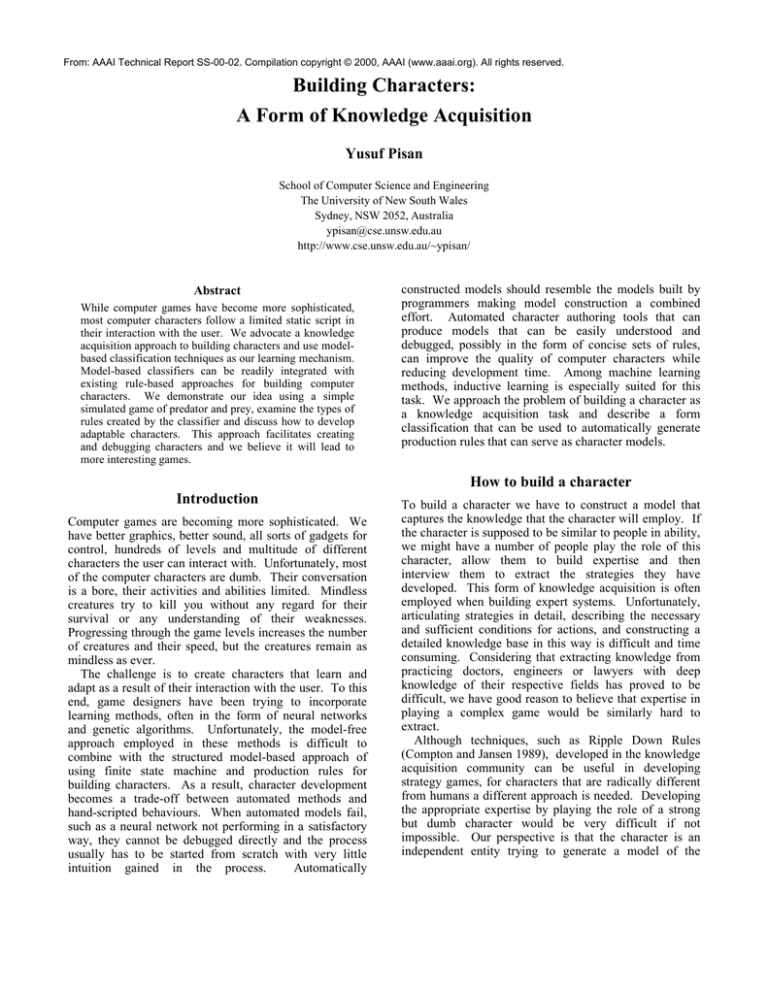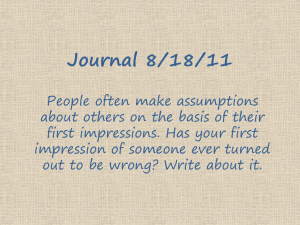
From: AAAI Technical Report SS-00-02. Compilation copyright © 2000, AAAI (www.aaai.org). All rights reserved.
Building Characters:
A Form of Knowledge Acquisition
Yusuf Pisan
School of Computer Science and Engineering
The University of New South Wales
Sydney, NSW 2052, Australia
ypisan@cse.unsw.edu.au
http://www.cse.unsw.edu.au/~ypisan/
Abstract
While computer games have become more sophisticated,
most computer characters follow a limited static script in
their interaction with the user. We advocate a knowledge
acquisition approach to building characters and use modelbased classification techniques as our learning mechanism.
Model-based classifiers can be readily integrated with
existing rule-based approaches for building computer
characters. We demonstrate our idea using a simple
simulated game of predator and prey, examine the types of
rules created by the classifier and discuss how to develop
adaptable characters. This approach facilitates creating
and debugging characters and we believe it will lead to
more interesting games.
constructed models should resemble the models built by
programmers making model construction a combined
effort. Automated character authoring tools that can
produce models that can be easily understood and
debugged, possibly in the form of concise sets of rules,
can improve the quality of computer characters while
reducing development time. Among machine learning
methods, inductive learning is especially suited for this
task. We approach the problem of building a character as
a knowledge acquisition task and describe a form
classification that can be used to automatically generate
production rules that can serve as character models.
How to build a character
Introduction
Computer games are becoming more sophisticated. We
have better graphics, better sound, all sorts of gadgets for
control, hundreds of levels and multitude of different
characters the user can interact with. Unfortunately, most
of the computer characters are dumb. Their conversation
is a bore, their activities and abilities limited. Mindless
creatures try to kill you without any regard for their
survival or any understanding of their weaknesses.
Progressing through the game levels increases the number
of creatures and their speed, but the creatures remain as
mindless as ever.
The challenge is to create characters that learn and
adapt as a result of their interaction with the user. To this
end, game designers have been trying to incorporate
learning methods, often in the form of neural networks
and genetic algorithms. Unfortunately, the model-free
approach employed in these methods is difficult to
combine with the structured model-based approach of
using finite state machine and production rules for
building characters. As a result, character development
becomes a trade-off between automated methods and
hand-scripted behaviours. When automated models fail,
such as a neural network not performing in a satisfactory
way, they cannot be debugged directly and the process
usually has to be started from scratch with very little
intuition gained in the process.
Automatically
To build a character we have to construct a model that
captures the knowledge that the character will employ. If
the character is supposed to be similar to people in ability,
we might have a number of people play the role of this
character, allow them to build expertise and then
interview them to extract the strategies they have
developed. This form of knowledge acquisition is often
employed when building expert systems. Unfortunately,
articulating strategies in detail, describing the necessary
and sufficient conditions for actions, and constructing a
detailed knowledge base in this way is difficult and time
consuming. Considering that extracting knowledge from
practicing doctors, engineers or lawyers with deep
knowledge of their respective fields has proved to be
difficult, we have good reason to believe that expertise in
playing a complex game would be similarly hard to
extract.
Although techniques, such as Ripple Down Rules
(Compton and Jansen 1989), developed in the knowledge
acquisition community can be useful in developing
strategy games, for characters that are radically different
from humans a different approach is needed. Developing
the appropriate expertise by playing the role of a strong
but dumb character would be very difficult if not
impossible. Our perspective is that the character is an
independent entity trying to generate a model of the
world. This perspective allows us to adapt the tools used
by the knowledge acquisition community.
Classification
It is possible to view the expert decision about a situation
as a classification task. In medical diagnosis, if we have a
large database of patient records with their associated
diseases, we can inductively construct a model by
generalising from specific examples. In a computer
game, the character can decide what the next action
should be based on what its observations and its historical
data. From this perspective, the character is similar to a
baby trying to create a model of the world based on the
information it has access to. In a deterministic world
where the character has access to all the world
information, character’s model would converge to the
world model. A more interesting model emerges when
the world is non-deterministic, the character has access to
a limited set of features about the world, possibly defined
by its sensors and the character as limited memory. In
this case, the model created is the set of rules that can fit
historical data most accurately.
Given sufficient data that includes all the relevant
features necessary to classify the case, an inductive
learner will converge to the appropriate classification
model. What constitutes sufficient data depends on the
complexity of the underlying model and the amount of
noise in the data. For computer games, the character has
to model the a subset of its world based on its sensors
through experimentation. We are interested in the
evolution of the models that the characters create based
on their limited access to world features.
A Small experiment
We created a toy example where a fox hunts rabbits,
squirrels and chipmunks to illustrate the how rules
generated by a classifier evolves under different
conditions. In this world, when the fox sees a prey, it has
to decide whether to hunt or to rest. The current state of
the fox is defined by its attributes shown in Table 1. The
rules determining whether the fox can successfully hunt is
given in Table 2. We ignore the states where there is no
visible prey. There are a total of 24,000 possible states
the fox can be in, and the fox can successfully hunt in
only 10% of them. We are interested in how the quality
and the accuracy of the rules fox develops changes with
data while making sure that the concepts expressed as
rules remain easy to interpret.
Fox’s Attributes
Range of Values
speed
hunger
distance
mood
terrain
1..10
1..10
1..10
happy, sad
grassland, forest, swamp,
mountain
prey type
rabbit, squirrel,
chipmunk
Table 1: State attributes for fox
Rabbit
Squirrel
Chipmunk
speed > 7
speed > 5
speed > 3
hunger > 7
hunger > 5
hunger > 3
distance < 5
distance < 7
distance = any
mood = sad
mood = any
mood = happy
terrain = forest, terrain = forest terrain = any
grassland
Table 2: Conditions for a successful hunt
We use C4.5 (Quinlan 1993) as our classifier. While a
number of other classifiers are available, such as CART
(Breiman 1984), C4.5 is well-known in the machine
learning community and commonly used as a reference
program to test new classifiers against. Most importantly
for our purposes, C4.5 generates a set of production rules
as its model which can be easily examined by
programmers.
We randomly generated 10, 100, 1000 and 10,000
cases, classified them according to the rules from Table 2,
and examined the models derived by C4.5. The generated
cases reflect the distribution of successful hunts in the
state space. As a result, approximately 10% of the cases
in each data set would be labelled “HUNT” and 90%
would be labelled “REST”.
For 10 cases, the model generated consists of a single
rule with no conditions and “REST” as its result. This is
as expected since the number of cases is insufficient to
make any generalisation for when to hunt. Since we are
only interested in whether a given state is a good
candidate for hunting and no penalty is associated with
resting, for a randomly chosen state resting is the right
choice.
When 100 cases, representing approximately 0.4% of
the state space, is used as input the rule for hunting
chipmunks, as given in Table 2, is correctly derived. No
rule for hunting squirrels or rabbits is found. Based on
the rules we have specified, chipmunks are easiest to
hunt. Of the 8000 possible states with chipmunks,
hunting a chipmunk is successful in 1960 states (or 25%
of the time), compared with hunting rabbits which is
successful only 0.9% of the time.
For 1000 cases, the rule for hunting chipmunks and
squirrels is correctly derived, but the rabbit rule continues
to be missing. Of the 294 cases involving rabbits only
one case is labelled to be a good choice for hunting
rabbits and is not generalised as a result.
For 10,000 cases, the rule for hunting chipmunks,
squirrels and the two additional rules for hunting rabbits is
correctly derived. Each rule is made up of conjuncts so
two rules are required to specify hunting a rabbit in for
grassland or in forest.
When we introduce 5% noise into the data, the rules
generated deteriorate slightly with over-constrained and
under-constrained conditions for 100 and 1000 cases. For
10,000 cases the correct rules are derived successfully
under 5% and 10% noise, but rules with faulty conditions
start appearing when the noise level is increased to 20%.
A faulty rule derived for 100 cases with noise level at 5%
is given below with the correct conditions on the right.
Rule 4:
animal = SQUIRREL
speed > 4
X speed > 5
hunger > 5
X missing distance < 7
X missing terrain = FOREST
-> class HUNT
As expected, the underlying concepts were discovered
with increased accuracy as the number of cases increased.
The effect of noise deteriorated the rules produced for
smaller data sets, but the larger data set was not effected
by noise until the noise level was increased to 20%.
There are two interesting results. First, it was possible
to derive the correct rules with only a small sampling of
the state space. Second, the rules produced reflected the
experience of the character and were easy to understand
and modify by programmers.
In this simple example, fox eventually learns the rules
for a successful hunt. There are a number of ways in
which we can increase the complexity of this game: by
making the fox starve after a set number of unsuccessful
hunts, by changing what percentage of knowledge is
inherited by offspring, by limiting the number past hunts
that can be remembered, by changing the rules of the hunt
gradually and by allowing the prey to learn as well. In a
well-tailored scenario, the fox would never become the
perfect hunter, but would have setbacks followed by
learning periods where its hunting improves.
We have focused on the behavioural aspects of
characters, but a similar approach can also be used for
conversational agents. First, we can use the same set of
strategies to determine the level of knowledge that the
character has. The level of knowledge directly effects the
content of the conversation. Next, conversation can be
used as a tool to change the attitude of another character
where learning takes place in the form of differentiating
what is the appropriate attitude or phrase to use with
different characters. Complex conversations that require
planning are currently beyond the scope of what can be
achieved by classifiers.
Although classification is a powerful technique, the
number of examples required to develop complex
strategies is not feasible for many applications. However,
classification techniques are appropriate for our goal to
create characters that are developed by a combination of
hand-scripting and automated tools. Classifiers that
generate easy to modify rules make the learning process
visible to the programmer and make it easier to debug and
develop complex characters.
Conclusion
The biggest advantage of using classification as a model
building tool is its simplicity (hence speed); the
disadvantage is that the cases have to be described in the
form of an attribute-value description. Learning methods
that create explicit models that can be understand by
programmers can be more easily integrated and tested.
The form of classification technique we have used does
not handle varying rewards or time delayed rewards.
Other reinforcement learning techniques that address
some of these issues, such as Q-learning (Watkins and
Dayan 1992)
(Barto, Sutton et al. 1983), lack
the explicit models which make them unsuitable for our
purposes. Convergence to the right model has become
one of the factors in evaluating learning systems. While a
classification system, such as C4.5, as well as Q-learning
conditions, the behaviour exhibited and the models
created during this convergence is what makes interesting
characters rather than their discovery of the optimum
strategy. For computer games, this convergence would be
intentionally slowed down or crippled to create
environments that are continuously changing.
Characters in a computer game have dual roles. Their
first role is to react to and learn from their environment.
This can be achieved by any learning method or by clever
programming. Their second role, entertainment, requires
artistic intervention by designers and can be best achieved
if the character models remain accessible to programmers.
References
Barto, A. G., Sutton, R. S. and Anderson, C. W. 1983.
Neuronlike adaptive elements that can solve difficult
learning control problems. IEEE Transactions on Systems,
Man, and Cybernetics 13(5):834-846.
Breiman, L. 1984. Classification And Regression Trees.
Belmont, California: Wadsworth International Group.
Compton, P. and Jansen, R. 1989. A philosophical basis
for knowledge acquisition. In Proceedings of the Third
European Knowledge Acquisition for Knowledge-Based
Systems Workshop, 75-89. Paris.
Quinlan, J. R. 1993. C4.5: Programs for machine
learning. San Mateo, Calif.: Morgan Kaufmann
Publishers.
Watkins, C. J. C. H. and Dayan, P. 1992. Q-learning.
Machine Learning 8(3):279-292.




